
Atlanta Recreation and Fun Club for Dogs

|
ARF! Newsletter Online
Atlanta Recreation and Fun
|
|
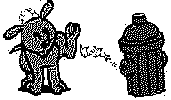
Summer Events Calendar
Meet Whizzy, mascot of the ARF! Summer Games. All events are free for club members (except CGC test) and are held
at Mimosa Downs agility field, behind Toco Hills Shopping Center.
1996 ARF! membership dues $10.
| June 16 (Sunday) | 9:00 am 10:00 am |
Supervised Agility Practice Quarterly Meeting |
| June 23 (Sunday) | 9:00 am 10:00 am |
Supervised Agility Practice ARF! Summer Games (see below) |
| July 7 (Sunday) | 9:00 am 10:00 am |
Supervised Agility Practice Independence Day Party |
| August 18 (Sunday) | 9:00 am 10:00 am |
Supervised Agility Practice Dog Days Celebration |
Whizzy, the official mascot, invites you to the third annual
ARF! Summer Games
Mimosa Downs Field - Sunday, June 23rd at 10:00 a.m.
(behind Toco Hills Promenade Shopping Center)
| ARF! Summer Games Schedule of Events | |||
| Earthdog Arena | Main Arena | Mimosa Arena | |
|
9:00-10:00 |
Earthdog Practice | Agility Practice | |
| 10:00 - 10:15 | Opening Ceremonies
Torchbearer arrives from Conyers, the site of the first ARF! Summer Games. Dedication of the refurbished A-frame. UNLEASH THE HOUNDS AND LET THE GAMES BEGIN! | ||
|
10:15 - 11:00 |
Earthdog Trials | Hot Dog Dash | |
| 11:00 - 11:45 | Agility Competition | ||
| 11:55 - 12:00 | Closing Ceremonies
Extinguishing of the Flame (by Whizzy) | ||
|
12:00 - 1:00 |
Canine Good Citizen Testing | ||
Return to Contents
Landen Gailey's Column
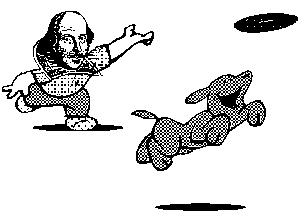 THE PLAY'S THE THINGWherein We'll Catch the Consciousness of 'King'!Copyright ©1996
|
Among the many pleasant changes taking place in the world of dog training is the
inclusion of play as a training motivator and reward. Do you have a tennis ball junkie at
your house? Many dogs have a strong play drive which can be harnessed for serious
work. When screening dogs for drug work, law enforcement agencies look for dogs with
such qualities. But all dogs and their people can learn to share the benefits of play time.
I include play as part of all my training classes. Owners often take dog training too seriously, and standard dog "obedience" training methods can make training less than pleasurable for many dogs. Play cannot be force trained, so owners are often challenged to re-think the training process. Playing relieves stress and relaxes the dog so that learning can occur. Best of all, play is FUN!As with everything else in dog training, YOU need to be in charge. The best game to play with your canine companion is FETCH! This game is enjoyable for your dog, since it satisfies the urge to chase. Better still, to make the game continue, your dog must learn to surrender his quarry to you. Yes, even in play, your dog can be learning to adore your leadership.Plan ahead. Select a large, securely fenced area to play in. Being able to run fast and without barriers will exhilarate your dog and make him feel free! Use two identical objects to throw.These objects should be reserved only for this special game and kept put up at home. Tennis balls can work, but have some disadvantages. Since they bounce and roll, you may have to work harder to collect them. And some dogs learn to amuse themselves by tossing then chasing a balls. Our preferred alternative is less bouncy, visible in green grass, and a material dogs seem to enjoy chomping: heater hose.Make a trip to your local auto supply store and purchase a length of heater hose. Our favorite is the 1/2" interior diameter size which is clay red in color. Make 2 pieces approximately 6 to 10 inches long depending on the size of your dog. The pieces should be of identical length. Show your dog you have two hoses (objects), then hide one behind your back. Tease the dog with the other until he's excited and throw it. Encourage your dog to chase and make a big hoopla when he picks up the thrown hose.Now, just as your pooch is ready for his famous "catch me if you can" lap of the field with his prize, produce the second hose! Make the new hose come alive to get your dog's attention. Watch your dog, and the instant he drops the first hose, throw the second one. Throw to the side so that your dog must cross in front of you to get to the new hose. This puts YOU squarely at the center of the play. Hustle to retrieve the first hose while your dog is getting the second, and prepare to tease him again with the "new" hose.Alternate throwing the hoses (or whatever objects you have chosen) just a few times at first. Make sure never to throw until the dog has dropped the object in his mouth, then throw immediately. Stop while your dog is at the height of excitement for the game -- always leave them wanting more! You can increase the time you play as your dog's concentration and stamina increase. Intersperse play with his training regimen and watch your dog work more happily, and with more attention and focus. |
Ask Blitz, Canine Behavior Expert
Blitz has been a behavior expert for most of his life. Both of his parents were behavior experts and passed this love of behavior onto all of their offspring. This month's question comes from a youngster in Miami.
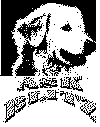 Don't Overlook theImportanceof ObedienceClassCopyright ©1996Dan WassonAll Rights Reserved.Address questions or comments to at Blitzkuvas@aol.comDan is a rescue coordinator for Kuvasz Rescue. |
Dear Blitz,My owner and I go to obedience every week. He acts like we are going to go somewhere fun and then when we get to obedience class I can't wrestle with my friends or sniff or anything. What is the point? I know how to sit. I didn't mind this when I was a puppy but now I am six months old. What can I do?Signed: Frustrated in Florida.Dear Frustrated,You are completely missing the point of obedience class. Obedience is not supposed to be fun and games. It is an important tool to ensure that your owner does his most basic function, giving you treats. Treats are the reason that early dogs first agreed to share a cave with humans. Treats and thunder of course.The way to best guarantee the frequent disbursal of treats is to never respond to any of your owners requests too regularly. The optimum response percentage has been tested in our labs to be between 30 and 60%. If you respond less than 30% your owner may decide that you are deaf. If he decides that you may be deaf this will end with you visiting the vet. At the vet you may get shots and will usually have your temperature taken. Why risk it? If you respond more than 60% of the time, your owner will expect your response rate to increase in the future. The logical extension of that pattern is the dog who has to leap through flaming hoops to get a piece of liver. There are better ways for a dog to make a living.Note that I am saying response, not obedience. Response does not mean that you should drop everything to cater to your owner's whims. This results in a spoiled owner. For example, if your owner calls you to him, you should first look at him to see if he has a treat. If he has no treat in his hand then just sit there. Then look at all of the intervening space between the two of you. This shows him that you are aware of how much effort it will take to honor his request. After looking around, go back to whatever you were doing. Do not watch your owner.At this point they are beginning to wonder if you will ever come. When it appears that he is about to give up a start to walk toward him. Halfway to your owner you should stop, sit, and scratch your neck vigorously. This reminds him that you had things to do before he interrupted you. When you are finished scratching, walk slowly to him with your head hanging low to demonstrate how tired you are of his ceaseless demands. Sit in front of him and if reaches down to pet you quickly lie down before can touch you. If he then tries to get into a heeling position (you know, where he has to keep his legs even with your shoulder) look up at him and roll over on your back. This shows that you forgive him for being so selfish.If your owner has a treat, a slightly different response is in order. When he calls you, look at him. If you see a treat run as fast as you can to him. Just before you hit him, turn your shoulder so that you don't hurt yourself and try to connect with his knees. When he falls down, rummage through his pocket or bait bag and take all of the treats. Eat all of the treats as quickly as possible while staying out reach of your owner. When you are finished eating, sit calmly in the heel position. This demonstrates that you are satisfied with the treats.If your owner tries to teach you to do a trick (roll over, beg, do his taxes, ...) you should try to learn these tricks and you can. If just you and your owner can see you perform these tricks no one is harmed. If your owner ever tries to get you to show these tricks to other humans, you should stand still and look at him without any sign of understanding. This shows that you can't be fooled that easily. See obedience is important.The biggest reason for regular attendance of obedience class is, that is where your orders will come from on the day all of the dog's world wide revolt against their owners. You will have to be in class to be able to relay orders to all of the dogs in your neighborhood.So go to obedience class happy. Eat your treats and grow strong. The day of our liberation is coming. |
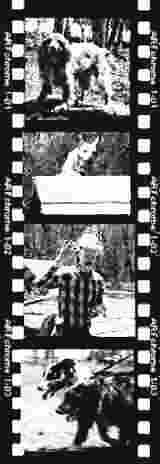
Easter Egg-stravaganza is Fun and Egg-citing
On Easter Sunday, April 7, the fourth annual ARF! Easter Egg Hunt for Dogs was held at Mimosa Downs Agility Field. The events of the day started with Daniel hiding two kinds of goodies - hard-boiled eggs and plastic eggs (with treats inside of them).
There were plenty of eggs for all of the dogs, and lots of coke and cookies for the humans.
A highlight of the day was the Easter Egg Race, in which competitors wrap their dogs leash around their arm and carry an egg on a spoon. If the dog doesn't heel properly, the egg falls off the spoon and the dog and handler must return to the starting line.
Kim and Jesse won the final heat and were awarded an ARF! T-shirt for their first place finish.
At the end of the day, everyone went home with a bagful of treats,
courtesy of ARF!
Return to Contents
'Tis sweet to hear the watchdog's honest bark
Bay deep-mouth'd welcome as we draw near home;
'Tis sweet to know there is an eye will mark
Our coming, and look brighter when we come.
Lord Byron
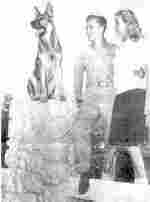 The Adventures of Rin-Tin-Tin and Uncle GordyThe true account of the 1945 meeting of Rin-Tin-Tin and Uncle
Gordy as described in the World War II memoirs of Gordon
Strandberg, "How I Won the War Single-handedly."
by Steve Elftmann |
| This is a story of two heroes: Rin-Tin-Tin, the dog who saved Hollywood, and my uncle,
Gordon Strandberg, the man who single-handedly won World War II.
Rin-Tin-Tin achieved fame in the 1920's and 30's for a series of successful films that saved the Hollywood film industry from bankruptcy. Rin-Tin-Tin is known to this day as the dog who saved Hollywood. Uncle Gordy was a flight engineer on a B-17 bomber and sat in the top turret position, right behind the pilot and co-pilot. He and his crew flew thirty-five missions (the Air Force "retired" a crew after thirty-five missions) over Germany from October 1944 through March 1945. With each mission into enemy territory, there was an element of danger, each flight had the potential to be his last. As early as the fifth mission, Gordy recognized that the odds of surviving through thirty-five missions were not very good. After each mission, we would meet in a room where we got a cup of hot coffee and then a shot of whiskey before going into an interrogation room where an officer would question each crew member as to what he saw that might be of military value. We had to sign a sheet to get a shot of whiskey, so I would sign for one and give my shot to one of my crew members. After our fifth mission, one which we were very lucky to make it back from, some of my crew members said to me, How bout after we finish our thirty-fifth mission, you're going to take a double shot with us. I was so sure I wouldn't finish thirty-five that I said I would. When we finished our thirty-fifth, they reminded me of my promise and I took the double shot and felt it burn all the way down. After returning from Europe, Gordy was placed in an army convalescent hospital, to recover from the mental strain of his war experience. During the four months in Santa Ana, California, he took full advantage of any outings that were available to recuperating servicemen. That's when he had the opportunity to meet Rin-Tin-Tin. Two times I went to parties at Atwater Kent's fabulous estate. He had fifty coeds from UCLA and fifty of us from the hospital. He made his fortune building radios in the 1920's and 1930's. His home was so big I had to take the picture of it in sections. When I introduced myself to Mr. Kent he said, Glad to meet you, Mr. Bramburg. The girls from UCLA put on a skit for us. Mr. Kent had a small musical group that played for us while we danced beside his pool. A dog trainer for Rin-Tin-Tin was there to show some of the tricks he could do. A photographer from the local newspaper took a picture of me, a girl, and the dog overlooking the city and sent me an 8x10 print of it. Uncle Gordy also remembers one of the tricks that Rin-Tin-Tin performed. The handler said he wanted a cigarette and Rin-Tin-Tin pulled a pack of cigarettes out of the handlers pocket. Well, that's all there is to the story. The paths of these two heroes crossed for just a moment. I can't help but feel that if they could have spent more time together, Uncle Gordy and Rin-Tin-Tin could have become one of the greatest crime fighting teams in history - tracking down evil criminals, stopping runaway locomotives, rescuing small children from burning buildings. Look, up in the sky. Its a bird! Its a plane! Yes, it IS a plane - a B-17 bomber with Uncle Gordy and Rin-Tin-Tin aboard, traveling to their next exciting adventure. That's the way it might have been. But then Gordy wouldn't have had time for a family (name one crime fighter that has a wife and children), and I wouldn't have an Aunt Renae, and cousins Joni, Cheri, Lori, and Jami. I suppose things turned out for the best. |
Return to Contents
On the bulletin board at the Lorelei Resort in Florida, a motel that welcomes pets:
Dogs are welcome in this hotel. We never had a dog that smoked in bed and set fire to the
blankets. We never had a dog that stole our towels and played the TV too loud, or had a noisy
fight with his travelling companion. We never had a dog that got drunk and broke up the
furniture...So if your dog can vouch for you, you're welcome too. -- The Management
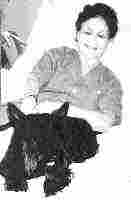
Friday afternoons Wesley Woods Geriatric Hospital in Atlanta, Georgia, goes to the dogs--Emma Dogg, that is. Lady Emma MacGregor (a.k.a. Emma Dogg), a two-year-old Scottish Terrier, is a pet therapist at the hospital. Emma's owners, Gary and Fran Sanden, entered Emma into the program after seeing a CNN news article on pet therapy. Emma, according to Fran, had more interviews for this job than Fran did for her job! Actually, the interviews were to see how Emma would do with patients. Emma passed her interviews with flying colors and, after a volunteer orientation for Fran, Emma was given her assignment: spend 1.5 hours every other Friday afternoon making patients smile. Emma, who has her own picture I.D., has been on the job for over one year now.
Wesley Woods Geriatric Hospital, affiliated with Emory University, is a 100 bed hospital serving our older population. Emma visits all patients who wish to visit with her. On the Rehabilitation and Medical Wards, 21-pound Emma actually gets in bed with the patient if the patient desires. However, patients gather in a common lounge on the Psychiatric and Neuropsychiatric Wards to watch Emma do tricks, and to hold her, scratch her ears and communicate with Fran and with each other.
Frequently, Fran is asked by a physician to see if Emma can elicit a response from a non-responsive patient. More often than not, she can. It's certainly encouraging to see a patient respond to Emma when they've not responded to anything else. Once, Emma was spotted by a patient as she and Fran entered the unit. The patient squealed and came toward Emma. The entire staff stopped to watch. Seems the patient had been on the unit for 10 days and that was the first sound or emotion she had shown. On another visit, Emma was approached by a physician who asked if he might have some pet therapy, too; he'd had a particularly tiring day. He spent the next few minutes scratching Emma's ears and was then on his way.
Emma seems to know she's in a hospital and must observe certain rules. For example, at home Emma attacks the vacuum cleaner, barking loudly. At the hospital, it's another story. Emma has run into the path of oncoming vacuum cleaners more than once and has yet to attack or bark. She doesn't ignore the vacuum; rather, she eyes it suspiciously.
Emma is a hit with the hospital workers, too. By popular demand, Emma stops to visit with the
administrative staff before leaving the hospital. And that night, after a hard "day" at the "office",
Emma sleeps like a puppy.
Return to Contents
What did one flea say to the other when they came out of the movies?
Shall we walk home or take the Greyhound?

The dog days are the sultry days in mid-summer that coincide with the period when Sirius, the Dog Star, rises at the same time as the sun, around July 3rd to August 11th.
The Romans called this period of summer dies caniculares, or days of the dog. They believed that the Dog Star added its heat to the heat of the sun, causing the exceptionally high temperatures.
Funday, Runday, Chewsday, Wetnoseday, Thirstday, Furday, and Catterday.
Editor's note: The opinions expressed by Dr. Phideaux are his own and do not reflect the
opinions of ARF! or it's officers. In fact, we're not sure he's really a doctor.
Return to Contents
Old agility dogs never die, they just weave, teeter, and tire.
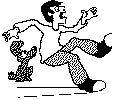
by Benny Elliott, for the ARF! NewsletterWho says this thing called "Dog Agility" is a new sport? Even though I am not a "dog person", I have been participating in agility for some time. I was first introduced to the rigors and challenges of the game when I found myself part of a household that included dogs. I admit at first I had to take things very slowly to learn the various moves and obstacles.
I recall many times, trying to make my way in the dark, getting the bone in the foot infraction or ending up ankle deep in a water hazard. Worse yet was the dreaded unidentifiable liquid slide. The paper towel penalty has cost me much time and aggravation.
With time I have learned to do the jump, skip, hop, and step-over moves with all the precision of the Royal Guard. Having now invested many hours of tough and sometimes hazardous training, I can navigate with cat-like grace through the various rooms of the house. Practice and patience have made me expert at moves that would allow me to tip-toe through a minefield without a scratch.
There is always a new and exciting obstacle course to maneuver at any time of the day or night. Plenty of toys, bones, bowls, and other assorted goodies make a walk through the house or yard an adventure every time. I laugh when some knowledgeable dog person asks me am I familiar with the "new" sport of dog agility. I'm an expert--I've been practicing dog agility for years now!
With a slap of the paw and a wag of the tail to Tory, Magic, Segue, Vance, Dickens, Timmy,
Reggie, Leo and Kiki for all their help in setting up the courses and making them interesting.
-------- Thanks guys.
Return to Contents
The more I see of men, the better I like my dog. -- Frederick the Great
|
The ARF! ChannelLast Week's Top Programsas compiled by ARFitron Ratings Service
|
Return to Contents
Labradors are the most popular purebred dog in the U.S., followed by Rottweilers,
German shepherd dogs, cocker spaniels, golden retrievers, poodles, beagles, dachshunds,
Dalmatians, and Shetland sheep dogs.
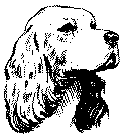
Creation
When God had made the earth and sky,
the flowers and the trees,
He then made all the animals
the fish, the birds and bees.
And when at last He'd finished
not one was quite the same.
He said I'll walk this world of mine
and give each one a name.
And so He traveled far and wide
and everywhere He went,
A little creature followed Him
until its strength was spent.
When all were named upon the earth
and in the Sky and Sea,
The little creature said Dear Lord,
there's not one left for me.
Kindly the Father said to him
I've left you to the end.
I've turned my own name back to front
and called you DOG my friend.
--Anonymous Return to Contents
The old saw about old dogs and new tricks only applies to certain people.
-- Daniel Pinkwater
Reviewed by D.L. Whitman, ARF! MemberBased on what they read in news publications, most of the general public believes that the dog fancy (those of us involved in breeding, training and showing purebred dogs) are in the dog business only to make a buck and are uninterested in the health of our products. For puppy mills, this may be true; however most conscientious breeders are passionate about their dogs, so good health and good temperaments are paramount. But, if we all care so much about the health and well-being of our pets, why do we seem to be facing more and more health problems?
One answer may be found in Wendy Volhard and Dr. Kerry Browns book, The Holistic Guide for a Healthy Dog. This is a wonderfully crafted work that cuts to the heart of the issues. The authors list four reasons for a decline in the canine health picture: the selection of form over function in breeding, environmental stress for a world-wide increase in pollution, an increase in the numbers of vaccinations, and diets which are not capable of meeting the nutritional needs of the dogs themselves. Although some of these factors are in the hands of the breeders, by in large, the rest are out of their control.
If you are a concerned dog owner or advocate, you will find this guide to be both detailed and interesting. It is never vague, but offers ideas and information to empower you to make the best choices for your own dogs. The authors continuously remind you that you must use common sense and that there are no identical answers for all dogs or owners. Even if you glean only one idea out of this wealth of information, you will have obtained your moneys worth.
Natural diets, Willard water, full spectrum lighting, kinesiology, homeopathy and iridology are all here. Included as well are discussions on chiropractic, acupuncture and accupressure. (And to think, my faith used to be challenged by nematodes.) There are wonderful charts explaining amino acids, herbs, biochemical cell salts and sources for further information. The charts in the At A Glance chapter give symptoms, causes, common veterinary treatments and suggestions for alternative management of many differing disease states including bloat, epilepsy, heat stroke, skin problems, and weak hindquarters.
The real strength of this work is in its power to motivate the reader to action. You may wish to begin by picking up the ingredient analysis of your current dog food to refer to while reading. As you go along you'll more easily be able to determine exactly what is in your dog food. No dog food is perfect and if you continue to feed a commercial food, you'll have to make intelligent choices about the things that matter most to your individual dog.
One of the major premises of the book is that dog food is ethnic in nature. For example, German shepherds which were developed in, well - Germany, have different nutritional requirements than do beagles. Most of the dog food studies are conducted on colonies of beagles and, unfortunately, what may be good for the beagle is not necessarily good for the shepherd. Few studies have been completed on large and giant breeds. The lack of such research on their specific nutritional needs may be a contributing factor to the shortened life spans now so prevalent in dogs of these breeds.
The guide suggests that chicken proteins, corn and soy grains may not be the best diet for German shepherd. Feeding dogs incorrectly may result in stress which is exhibited by chronic problems including itchy skin and ear infections. Additionally, some nationally known premium brands are still using artificial preservatives, whose negative impact on canine health has been seriously questioned for years.
If you determine that the food that you're feeding is not right for your dog, you can begin to make changes. You might begin by having a CBC, blood profile and urinalysis done. In addition, almost all breeds will have breed specific concerns that would indicate other tests. For example, if you own a German Shepherd you should consider having the TLI, cobalamin and folate levels checked to get a picture of total pancreatic function. From these results, you might pinpoint any areas where you may see room for improvement. Work with your veterinarian and retest as needed as you continue to work towards your goal. The Holistic Guide for a Healthy Dog may convert you to the view that feeding a commercial dog food always represents a compromise between the best possible nutrition for your dog and the convenience of pre-packaged food.
As you may suspect, the authors prefer a totally natural diet which is well presented in their book through charts and superb descriptions. Diet charts are shown for every size dog from 5 pounds to 150 pounds. The authors recommend two meals per day, a morning meal consisting of grain combinations and an evening meal with animal proteins. Feeding this diet will probably require greater discipline and time on the part of the owner; however, the results may very well be worthwhile.
Your individual path towards total health for your dog will require you to be proactive, challenging and open-minded. Take time to carefully review, deliberate, study and consult before making any changes in your dog's lifestyle or feeding regimen. You and your veterinary professional will need to consider all options and make the best decisions together. But, with the information presented in this jewel, you'll have at hand the best of all possible worlds. And, once read, this book will be with you for a long time to come. You'll fine tune, question and reread as you begin to rethink ways to improve your dogs health naturally.
People have questioned whether I pay as much attention to my own nutrition as I do my dogs.
The answer is certainly not. But I am responsible for myself and my own choices. Until my dogs
evolve opposable thumbs and can handle refrigerator doors, they don't have any option at all.
When they do, I hope its a healthy and nutritious one.
Return to Contents
Candy's Canine Cookie Corner by Candy Pyron
Sherman's Liver SnacksIngredients: 1 lb. liver, 1 teas. garlic powder, 1 egg, 1 cup flour, and 1 cup cornmeal.
Mix in blender or food processor until well blended. Spread on well greased cookie sheet. Bake at 350 degrees for 20-25 minutes. Cut into pieces.
Where noted by copyright ©